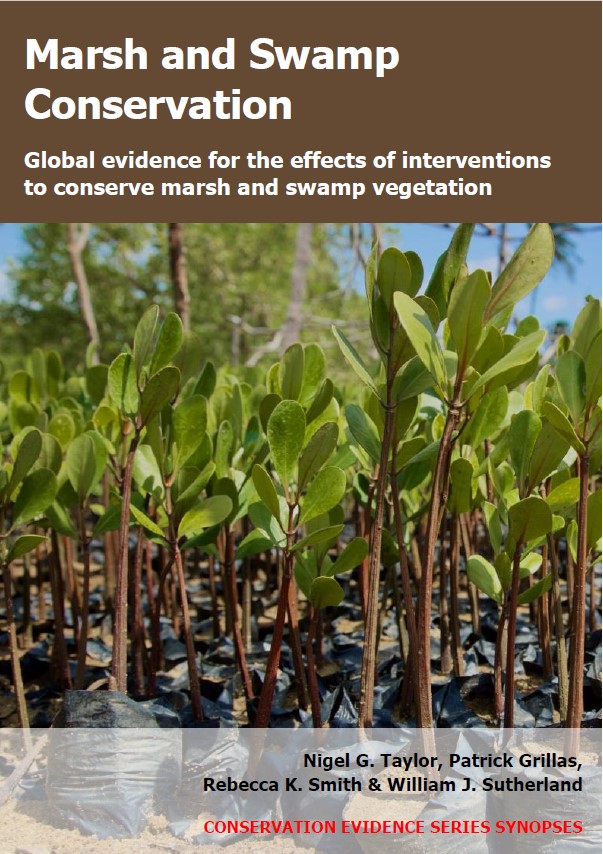Physically damage problematic plants: freshwater swamps
-
Overall effectiveness category Unknown effectiveness (limited evidence)
-
Number of studies: 2
View assessment score
Hide assessment score
How is the evidence assessed?
-
Effectiveness
50% -
Certainty
30% -
Harms
7%
Study locations
Supporting evidence from individual studies
A controlled study in 2002–2004 aiming to restore a swamp in a reed canarygrass Phalaris arundinacea stand in Wisconsin, USA (Hovick & Reinartz 2007) found that ploughing after spraying herbicide increased plant diversity and richness more than spraying alone, but that ploughing had no additional effect on the number of tree seedlings. After two growing seasons, the vegetation was more diverse in a ploughed/sprayed plot than in plots that had only been sprayed (data reported as a diversity index). The same was true for overall plant richness (ploughed/sprayed: 11.3; sprayed: 6.6 species/m2). However, the treatments did not significantly differ in native plant richness (ploughed/sprayed: 5.5; sprayed: 4.0 species/m2), or in the density of non-planted tree seedlings (ploughed/sprayed: 56; sprayed: 25 seedlings/m2). The study also reported differences between treatments in the abundance of individual plant species (statistical significance not assessed). For example, common vervain Verbena hastata was more abundant in the ploughed/sprayed plot (100% of quadrats; 20% cover) than sprayed plots (40% of quadrats; 3% cover). Reed canarygrass was less abundant in the ploughed/sprayed plot (40% of quadrats; 18% cover) than sprayed plots (100% of quadrats; 73% cover). Methods: Nine plots were established in a canarygrass-invaded wetland. All nine plots were sprayed with herbicide (Roundup®) in November 2002, and planted with tree/shrub seedlings (roughly 1 seedling/m2) in spring 2003. One plot was also ploughed, before planting, in spring 2003. This plot was slightly higher and drier than the unploughed plots. In August 2004, plant species and their cover were surveyed in ten 1-m2 quadrats/treatment, ignoring planted trees/shrubs.
Study and other actions testedA replicated, controlled study in 2006–2009 in a floodplain swamp clearing invaded by reed canarygrass Phalaris arundinacea in Wisconsin, USA (Thomsen et al. 2012) found that cutting, disking and applying herbicide to invaded plots increased tree seedling abundance after 1–3 years, and increased cover of herbs other than canarygrass after three years. In three of three years following intervention, treated plots contained more tree seedlings (4–44 seedlings/m2) than untreated plots (0–5 seedlings/m2). At the same time, treated plots had lower reed canarygrass cover (7–31%) than untreated plots (83–92%). Cover of herbs other than reed canarygrass did not significantly differ between treated and untreated plots in the first two years after intervention (treated: 15–47%; untreated: 16–22%), but was higher in treated than untreated plots in the third year (treated: 35–58%; untreated: 12%). Methods: In November 2006, twenty plots (roughly 810 m2) were established in a storm-created clearing within a floodplain swamp. Sixteen canarygrass-dominated plots were treated by cutting the vegetation (with a mechanical mulcher), disking the soil, and applying herbicide (four combinations of herbicide type and dose; repeated applications in summer and autumn until November 2008). The other four plots received none of these interventions. The study does not distinguish between the effects of cutting, disking and applying herbicide. Some tree species were planted and/or sown across the whole clearing. Vegetation (excluding planted trees) was surveyed in August 2007–2009, in four 2.25-m2 quadrats/plot.
Study and other actions tested
Where has this evidence come from?
List of journals searched by synopsis
All the journals searched for all synopses
This Action forms part of the Action Synopsis:
Marsh and Swamp Conservation
Marsh and Swamp Conservation - Published 2021
Marsh and Swamp Synopsis





)_2023.JPG)














